Java Unit Testing
Java Unit Testing is basically testing the Java application at the time of production. It is a method of testing the source code for fitment of use in a production environment. Java Unit testing helps in testing individual components of each unit in the software application. Unit is an individual testable component of software and is tested at the development phase.
Java Unit testing is one of the important steps in software designing and implementation, not only improves the effectiveness and efficiency of code but also reduces regression in further development and maintenance. In this article, we shall see the basic process of Java Unit testing, how to create the framework, and a few examples of testing applications.
Start Your Free Software Development Course
Web development, programming languages, Software testing & others
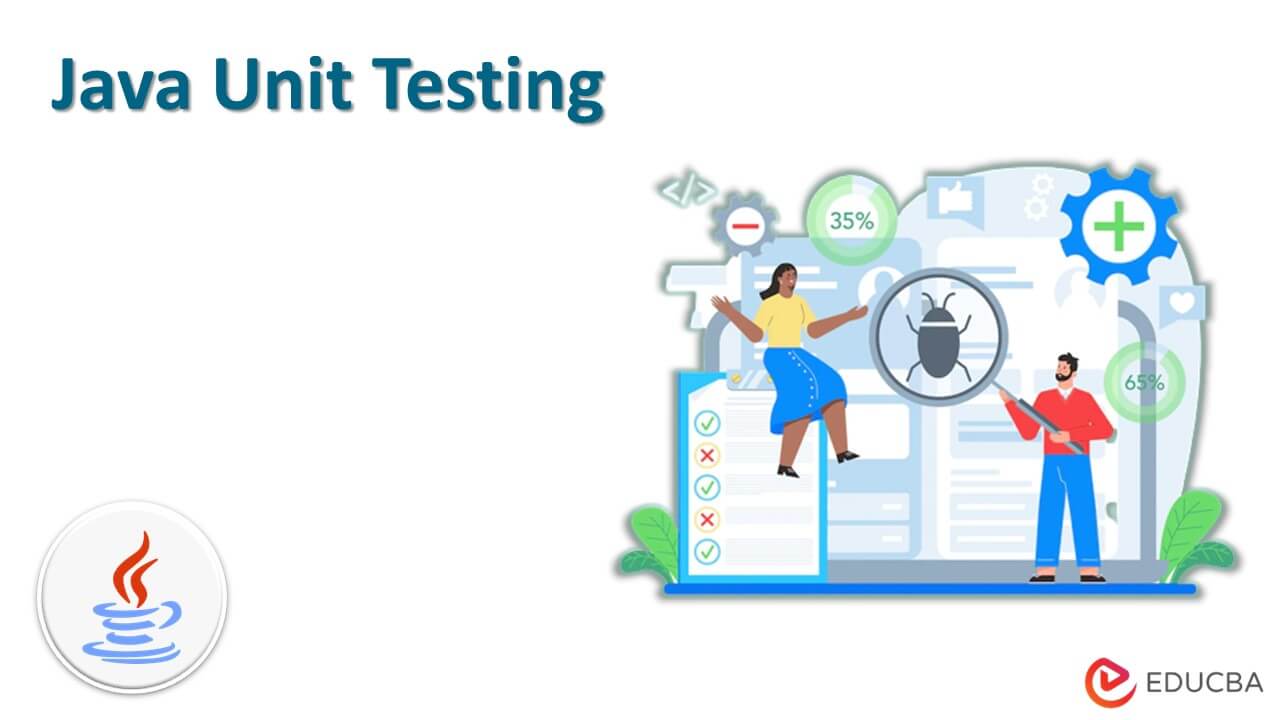
What is Java Unit Testing?
Java unit testing is a framework for JUnit, is one of the regression testing methods. It is an open-source framework used to read and write repeatable automation test cases. Java Unit testing isolates sections of code and verifies the correctness.
In STLC, SDLC, and V Model, Unit testing is the first level of testing the application before integration testing. Java Unit testing is a type of White Box testing which is executed by the developer itself. In the practical world, due to some issues or any other dependencies, Quality Assurance Engineers also do unit testing sometimes.
Basic Process of Java Unit Testing
- To perform Java Unit Testing, the user needs to create test cases. Unit test cases ensure program logic works as it is expected.
- junit is a package that contains interfaces and classes for junit testing.
- Junit is a method in class used only for testing, i.e., known as Test Class. To mark the method as a Test method, it is annotated with @Test annotation, which executes code under test.
- Users can also use Assert method or any other assert framework provided by Junit that helps to check the expected result with the actual result. These are called as asserts or assert statements.
- Generally, unit test cases are created in separate source folders to keep test codes separate from real source codes. Standard conventions from Gradle and Maven build tools to use are:
src/main/java – For Java Classes
src/test/java – For Test Classes
- Static imports are a feature of Java that allows methods and fields defined in the class as “public static” allowing to write shorter statements.
How to Create and Test Java Code with Junit Testing?
Given below shows how to create and test java code with junit testing:
Step 1: In the first place, to test Junit code, we need to have Java Logic in Eclipse or IntelliJ, or any other IDE. Download Eclipse as of now from https://www.eclipse.org/downloads/
Once downloaded, install it onto the system and launch it.
Step 2: Click on New – Java Project as below:
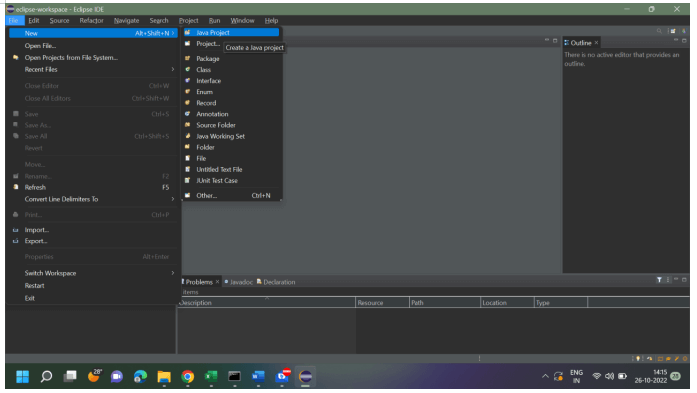
Give your project name and select JRE accordingly.

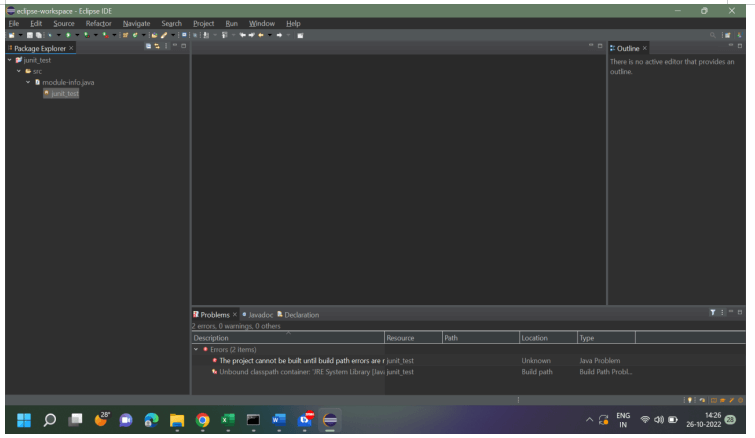
Step 3: Left side pane shows the java file. Then right-click on the project, and select New – Class
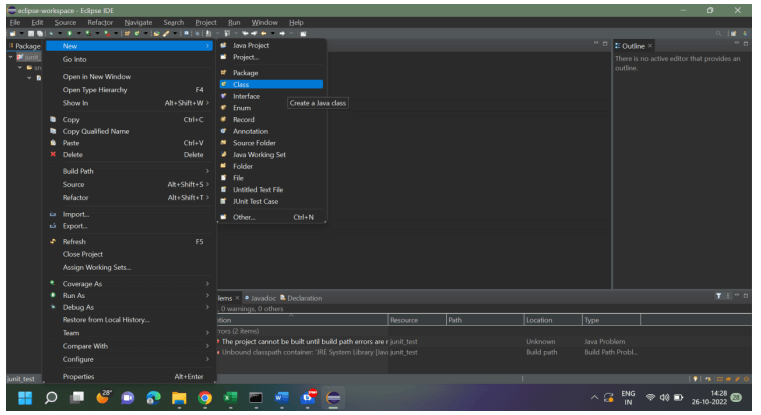
Enter the class name and click on finish.
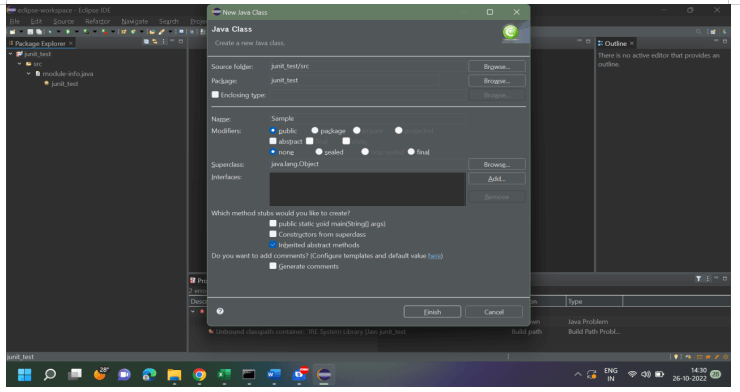
Step 4: Complete the class file as below with the given code.
Code:
package junit_test;
public class Sample {
int x, y;
void Math(int x, int y) {
this.x = x;
this.y = y;
}
public int sum() {
return x + y;
}
}Output:

Step 5: Now click on File – Junit Test case.
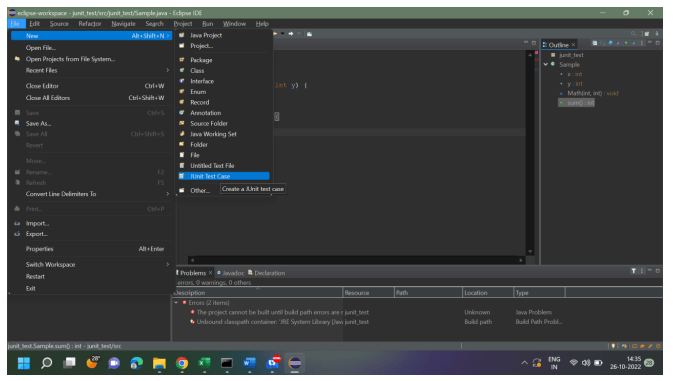
Select Junit Test 4 and select setup(), then click on Finish.
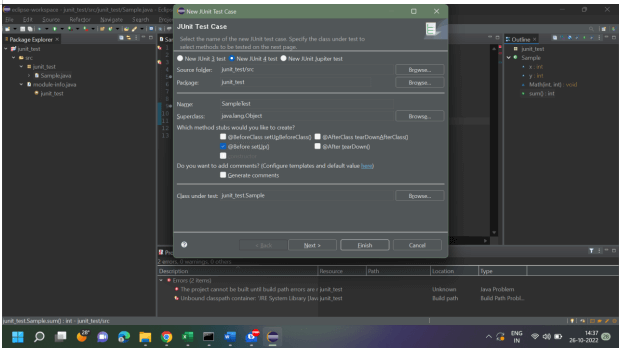
Click on OK.
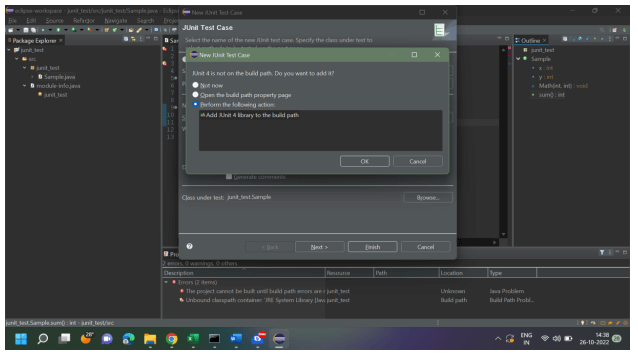
Below test code gets generated.
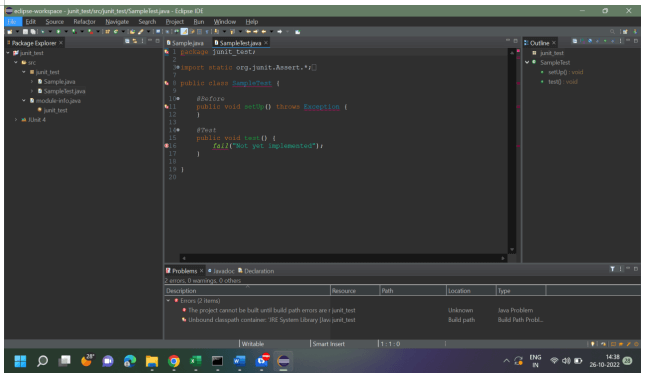
Step 6: Write the below code, for testing the functionality.
Code:
package junit;
import org.junit.Assert;
import org.junit.Before;
import org.junit.Test;
public class SampleTest {
Math math;
@Before
public void setUp() throws Exception {
math = new Math(8, 2);
}
@Test
public void testSum() {
Assert.assertEquals(17, math.sum());
}
}Output:
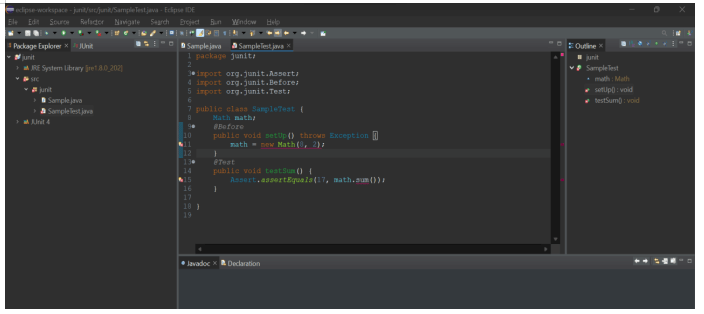
Step 7: Right-click on the Test file, and select Run as – Junit test case.

The left pane shows in green if the condition satisfies, i.e., functionality has been unit tested.
Java Unit Testing Framework and its Applications
Java Unit testing framework is a set of guidelines that are followed at the time of creating test scripts by using Java when performing quality testing of the software. These rules define the basic structure of test and strategy for testing lifecycle, such guidelines include scripting, test data information, repositories, test results, etc.
Below are the features of Java Unit Testing frameworks:
- Time Efficient: Time saved by formulating guided and structured test cases backed up by rules makes sure quality management is way much better.
- Cost Effective: Java Unit testing framework help in project cost management, reducing the waste or the expenditure that is caused by the allocation of resources or the shortcomings that might arise due to lack of management quality.
- Maximized Automation: The usage of testing frameworks helps to decrease human resource involvement in a testing environment, further automating the process in an efficient manner.
Listing out the most popular java testing frameworks with their applications.
1. Junit
As we have seen, this article is completely on the Junit testing framework, to describe in precise, Junit is an open-source testing framework that works on Java Virtual Machine. Junit focuses primarily on efficient execution and creation of unit testing for applications, and also establishes Test Engine API that helps to discover, and execute unit tests on the framework.
Junit supports various IDEs, like IntelliJ, Eclipse, VSCode, etc. It also provides a console launcher for launching the JUnit platform from the Java console.
Application: Junit is used by QA testers or developers to meet Junit and Regression testing requirements.
2. Selenium
It is an open-source testing tool for browser automation. Helps in creating test scripts using Python, Java, etc. to write automated test cases for web applications. Selenium has a web driver, grid, etc that helps in creating automated test cases on various browsers.
Application: Selenium is mostly used in cases where developers need it for cross-browser testing and for browser automation.
3. SerenityBDD
It is also an open-source framework that helps to write high-quality acceptance and regression test cases. Requirements are defined in terms of user stories for acceptance and are hence automated using JBehave.
SerenityBDD helps to keep track of the project and the application that has been tested.
Application: QA testers or developers use SerenityBDD for Regression testing and for Automated Acceptance testing, behavioural driven development.
4. TestNG
It is an easier version with a lot of functionalities including annotations and an arbitrary thread pool to run tests. The framework is versatile and designed to cover all categories like unit tests, functional tests, integration, and end-to-end tests.
Application: QA testers or developers opt for TestNG as it helps in Functional testing, Unit, and Integration testing along with end-to-end testing.
5. Mockito
It helps to minimize irrelevant interactions using expect run verify libraries. It focuses on testing selected behavior by proving ready to use, simple, and less expensive frameworks.
Application: QA testers and developers use Mockito to create a duplicate interface that can be used to test dummy functionalities in unit testing.
Conclusion
With this, we shall conclude the topic “Java Unit Testing”. We have seen what is Java Unit Testing, and what is meant by Junit along with the creation of a Unit test case with an example class file in Java. Also have seen various Java Testing frameworks and their applications.
The above is the detailed content of Java Unit Testing. For more information, please follow other related articles on the PHP Chinese website!

Hot AI Tools

Undresser.AI Undress
AI-powered app for creating realistic nude photos

AI Clothes Remover
Online AI tool for removing clothes from photos.

Undress AI Tool
Undress images for free

Clothoff.io
AI clothes remover

Video Face Swap
Swap faces in any video effortlessly with our completely free AI face swap tool!

Hot Article

Hot Tools

Notepad++7.3.1
Easy-to-use and free code editor

SublimeText3 Chinese version
Chinese version, very easy to use

Zend Studio 13.0.1
Powerful PHP integrated development environment

Dreamweaver CS6
Visual web development tools

SublimeText3 Mac version
God-level code editing software (SublimeText3)

Hot Topics
 1673
1673
 14
14
 1428
1428
 52
52
 1333
1333
 25
25
 1278
1278
 29
29
 1257
1257
 24
24
 PHP vs. Python: Understanding the Differences
Apr 11, 2025 am 12:15 AM
PHP vs. Python: Understanding the Differences
Apr 11, 2025 am 12:15 AM
PHP and Python each have their own advantages, and the choice should be based on project requirements. 1.PHP is suitable for web development, with simple syntax and high execution efficiency. 2. Python is suitable for data science and machine learning, with concise syntax and rich libraries.
 PHP: A Key Language for Web Development
Apr 13, 2025 am 12:08 AM
PHP: A Key Language for Web Development
Apr 13, 2025 am 12:08 AM
PHP is a scripting language widely used on the server side, especially suitable for web development. 1.PHP can embed HTML, process HTTP requests and responses, and supports a variety of databases. 2.PHP is used to generate dynamic web content, process form data, access databases, etc., with strong community support and open source resources. 3. PHP is an interpreted language, and the execution process includes lexical analysis, grammatical analysis, compilation and execution. 4.PHP can be combined with MySQL for advanced applications such as user registration systems. 5. When debugging PHP, you can use functions such as error_reporting() and var_dump(). 6. Optimize PHP code to use caching mechanisms, optimize database queries and use built-in functions. 7
 Break or return from Java 8 stream forEach?
Feb 07, 2025 pm 12:09 PM
Break or return from Java 8 stream forEach?
Feb 07, 2025 pm 12:09 PM
Java 8 introduces the Stream API, providing a powerful and expressive way to process data collections. However, a common question when using Stream is: How to break or return from a forEach operation? Traditional loops allow for early interruption or return, but Stream's forEach method does not directly support this method. This article will explain the reasons and explore alternative methods for implementing premature termination in Stream processing systems. Further reading: Java Stream API improvements Understand Stream forEach The forEach method is a terminal operation that performs one operation on each element in the Stream. Its design intention is
 PHP vs. Other Languages: A Comparison
Apr 13, 2025 am 12:19 AM
PHP vs. Other Languages: A Comparison
Apr 13, 2025 am 12:19 AM
PHP is suitable for web development, especially in rapid development and processing dynamic content, but is not good at data science and enterprise-level applications. Compared with Python, PHP has more advantages in web development, but is not as good as Python in the field of data science; compared with Java, PHP performs worse in enterprise-level applications, but is more flexible in web development; compared with JavaScript, PHP is more concise in back-end development, but is not as good as JavaScript in front-end development.
 PHP vs. Python: Core Features and Functionality
Apr 13, 2025 am 12:16 AM
PHP vs. Python: Core Features and Functionality
Apr 13, 2025 am 12:16 AM
PHP and Python each have their own advantages and are suitable for different scenarios. 1.PHP is suitable for web development and provides built-in web servers and rich function libraries. 2. Python is suitable for data science and machine learning, with concise syntax and a powerful standard library. When choosing, it should be decided based on project requirements.
 PHP's Impact: Web Development and Beyond
Apr 18, 2025 am 12:10 AM
PHP's Impact: Web Development and Beyond
Apr 18, 2025 am 12:10 AM
PHPhassignificantlyimpactedwebdevelopmentandextendsbeyondit.1)ItpowersmajorplatformslikeWordPressandexcelsindatabaseinteractions.2)PHP'sadaptabilityallowsittoscaleforlargeapplicationsusingframeworkslikeLaravel.3)Beyondweb,PHPisusedincommand-linescrip
 PHP: The Foundation of Many Websites
Apr 13, 2025 am 12:07 AM
PHP: The Foundation of Many Websites
Apr 13, 2025 am 12:07 AM
The reasons why PHP is the preferred technology stack for many websites include its ease of use, strong community support, and widespread use. 1) Easy to learn and use, suitable for beginners. 2) Have a huge developer community and rich resources. 3) Widely used in WordPress, Drupal and other platforms. 4) Integrate tightly with web servers to simplify development deployment.
 PHP vs. Python: Use Cases and Applications
Apr 17, 2025 am 12:23 AM
PHP vs. Python: Use Cases and Applications
Apr 17, 2025 am 12:23 AM
PHP is suitable for web development and content management systems, and Python is suitable for data science, machine learning and automation scripts. 1.PHP performs well in building fast and scalable websites and applications and is commonly used in CMS such as WordPress. 2. Python has performed outstandingly in the fields of data science and machine learning, with rich libraries such as NumPy and TensorFlow.




